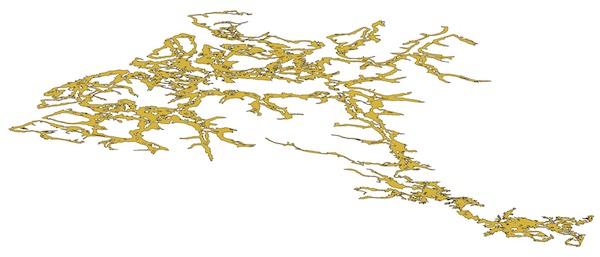|
CGAL 6.1 - 2D Polygon Repair
|
|
CGAL 6.1 - 2D Polygon Repair
|
This package implements polygon repair methods. Starting from possibly invalid input in the form of a polygon, polygon with holes or multipolygon with holes, the method computes an arrangement of the input edges, labels each face according to what it represents (exterior, polygon interior or hole), and reconstructs the polygon(s) represented by the arrangement. The method returns valid output stored in a multipolygon with holes.
Different labeling heuristics are possible. This package offers the even-odd rule, the non-zero rule, the union rule, as well as the intersection rule. The even-odd rule results in areas that are alternately assigned as polygon interiors and exterior/holes each time that an input edge is passed. It does not distinguish between edges that are part of outer boundaries from those of inner boundaries. The non-zero rule results in areas with a non-zero winding number. The union and intersection rules are useful when given two or more similar valid polygons with holes. The union rule results in areas that are contained in at least one of the input polygons with holes. Similarly, the intersection rule results in areas that are contained in all input polygons with holes.
Figure 16.1 Valid: (a) polygon, (b-c) polygons with holes, and (d-e) multipolygons with holes. (c) and (e) show cases where boundaries intersect tangentially at a single vertex.
Figure 16.2 Invalid: (a) self-intersecting polygon self-intersection, (b) self-touching polygon, (c-d) polygons with badly nested holes, (e) polygon with hole touching at edge, (f) polygon with hole that separates interior into two parts, (g) multipolygon with overlapping polygons, and (h) multipolygon with polygons that touch at an edge.
While the even-odd rule switches between inside/outside at each edge only taking into account multiplicity, the non-zero rule takes also into account the orientation of the edge.
For some configurations this leads to different results, as can be seen in the figure below.
Figure 16.3 Input (left), non-zero (middle) even-odd (right).
And there are other configurations where the two rules lead to the same result.
Figure 16.4 Input (left), non-zero and even-odd (right).
A valid polygon with holes, obviously has the same result with both rules applied as it is just the identity. However an invalid multipolygon with one polygon enclosing the other one results in the union of the two, that is the enclosing one for the non-zero rule, while it results in a polygon with hole for the even-odd rule.
Figure 16.5 Input (left), non-zero (middle) even-odd (right).
Given several valid polygons these rules apply a Boolean operation: In the arrangement of two valid multipolygons with holes, the faces that are in any and both multipolygons with holes are in the resulting multipolygon with holes for a union and intersection, respectively.
While this Boolean operation works for any two valid multipolygons, in the scope of repairing it serves to obtain an approximation from outside and inside when applying union and intersection, respectively, when the input is similar.
Figure 16.6 Union (top) and Intersection (bottom).
The conditions listed above are sufficient to define valid polygons, polygons with holes and multipolygons with holes for most applications. However, in order to ensure unique deterministic output from the repair algorithm, the valid multipolygons with holes returned by the package conform to more strict criteria:
If the input is already valid, the method will return a valid output representing the same area. However, the output might be different in order to conform to the stricter conditions to generate deterministic output.
Also, it is worth noting that even the repair of a single polygon without holes but with self-intersections can result in a multipolygon with holes. This is why the repair function will always return a multipolygon with holes. The user can then check whether it consists of a single polygon with holes, and if a polygon with holes has zero holes and extract these if needed.
It is possible to repair a polygon, polygon with holes or multipolygon with holes using the even-odd rule by calling the Polygon_repair::repair() function as shown in the following example. This function returns a repaired multipolygon with holes.
File Polygon_repair/repair_polygon_2.cpp
The method can repair large invalid polygons of millions of vertices in a few seconds as long as the number of intersections between line segments is limited. This is a realistic assumption with many invalid data sets, which only have relatively minor issues involving a small number of their vertices/edges. However, it is worth noting that there can be a potentially quadratic number of intersection between edges in the worst case, leading to much worse performance since all of these intersections need to be calculated in the overlay.
| Polygon | Vertices | Holes | Time |
|---|---|---|---|
 | 101973 | 298 | 0.652 sec |
 | 43925 | 125 | 0.190 sec |
The polygon repair method as originally developed is described by Ledoux et al. [1] and implemented in the prepair software. This package is a reimplementation of the method with a new approach to label and reconstruct the multipolygons. It also incorporates improvements later added to prepair, such as the application of the even-odd counting heuristics to edges, which enables correct counting even on partially overlapping edges.
Ken Arroyo Ohori developed this package during the Google Summer of Code 2023 mentored by Sébastien Loriot and Andreas Fabri. The GSoC project was limited to the even-odd rule. Further rules were added with CGAL 6.1 by Andreas Fabri.